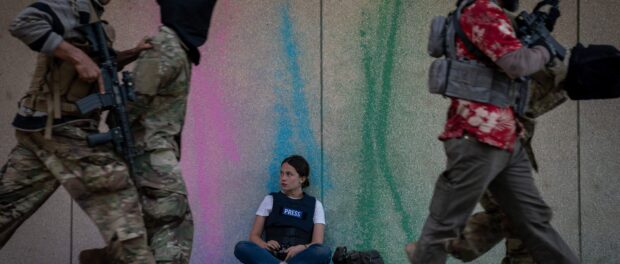Review: Civil War
A Trumpian figure, embodied by Nick Offerman, inches towards igniting a second Civil War, whispered through the shadows of dialogue, hinting at an illegal third term, the crumbling of the FBI, and a ruthless silencing of the press. In ‘Civil War,’ we’re placed into an America not too distant from our own, where a nation on the edge of collapse follows war photographer Lee Smith (Kirsten Dunst), alongside journalists Joel (Wagner Moura) and Sammy (Stephen McKinley Henderson), captures the clash between a fascist United States and secessionist factions spearheaded by Texas, California, and the Florida Alliance. Lee and Joel hatch a plan to journey to Washington, D.C. in pursuit of an interview with the President, before the secessionists forces can seize control. Meanwhile, Sammy insists on tagging along, eager to report from the front lines in Charlottesville, VA. Also, the addition of the aspiring young war photographer, Jessie (Cailee Spaeny), as they fight for survival and a chance to reach their destination in the nation’s capital.
Lee, Sammy, Jessie, and Joel venture into dangerous territories to fulfill their roles as truth-seekers and historians, capturing history in real-time. As they traverse the scarred landscape of America, they deal with the harsh realities of their profession, once shielded by privilege but now exposed to the horrors that are playing out.
Each passage through a state or town is fraught with danger as the locals assert their dominance with brutal authority, enforcing their own twisted laws, often with barbaric violence. Despite the illusion of security offered by the daylight hours, ‘Civil War’ shatters any notion of sanctuary. The film relentlessly reminds us that in the chaos of conflict, there exists no haven from danger. This truth is illuminated by the introduction of Jesse Plemons’s character. As always, Plemons delivers a performance that leaves viewers unsettled, embodying a figure liberated from the constraints of society’s conventions. A standout moment arises during the group’s harrowing encounter with Plemons. In this tense showdown, the clash between silence and noise becomes palpable, leaving the us on edge as Plemons commands attention with his chilling portrayal.
The film’s cinematography pays homage to their journalistic mission by seamlessly blending still photography from the journalists’ perspective with the movie’s shots, showcasing their impactful work. As part of the road trip genre, the film hinges on the chemistry among the cast, ensuring that accompanying them on their journey feels inviting rather than claustrophobic. The power of visual storytelling reigns supreme, weaving chaos through the lens of DP Rob Hardy’s camera, the images unfold with a visceral intensity. Meanwhile, the haunting soundscape, crafted by composers Ben Salisbury and Geoff Barrow, serves as a symphony of doom, amplifying the cacophony of gunfire, explosions, and the eerie silence that punctuates the air.
On the screen, America unfolds with skies ablaze, a canvas painted by rocket fire. Order and civility are long forgotten, replaced by savagery and an indifference to life’s worth. Garland’s film exposes the brutal truth of war, steering clear of political allegiance, instead revealing the grim consequences of societal fracture and polarization. Humanity is lost, and even the noble become monsters. Amid this chaos, the film pays homage to the unsung heroes of photojournalism, those courageous souls who risk life and limb to capture the unvarnished truth of our troubled times.
In the bleak landscape of a potential second Civil War in the United States, Alex Garland’s narrative sticks with you long after the credits roll, it’s the haunting melodies and the devastation wrought by conflict that linger in the mind, haunting and unforgettable.






